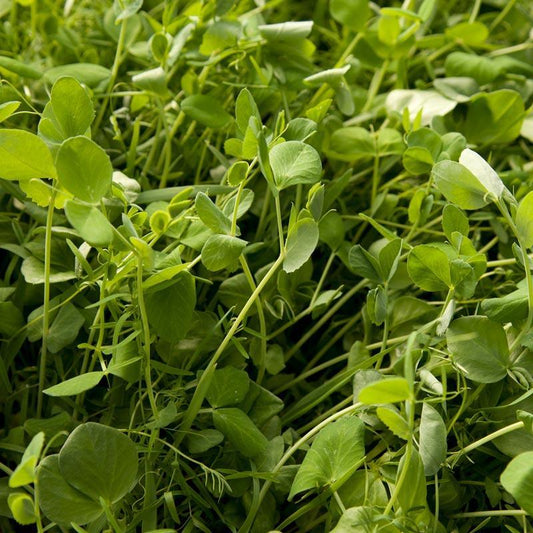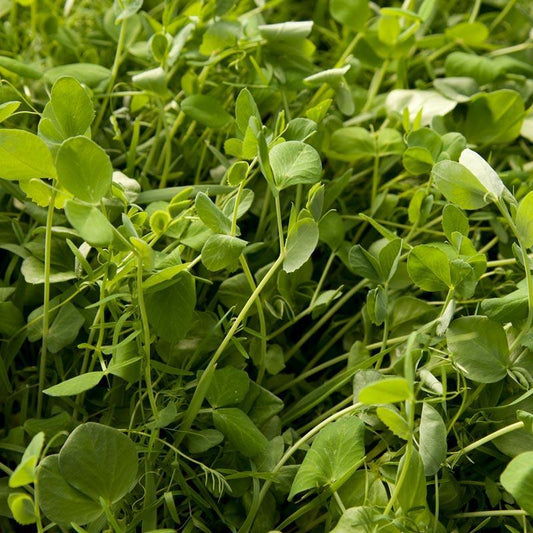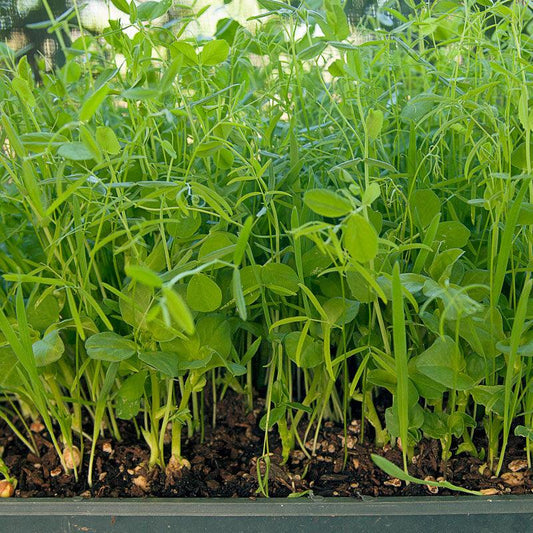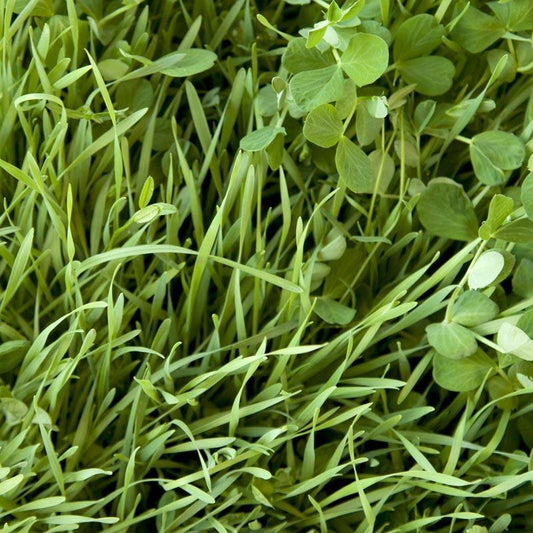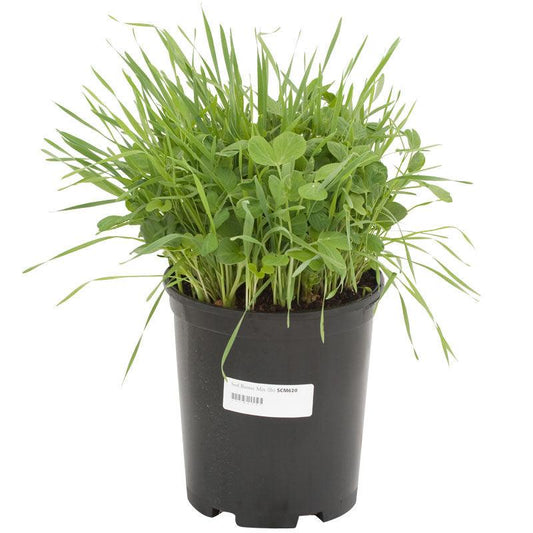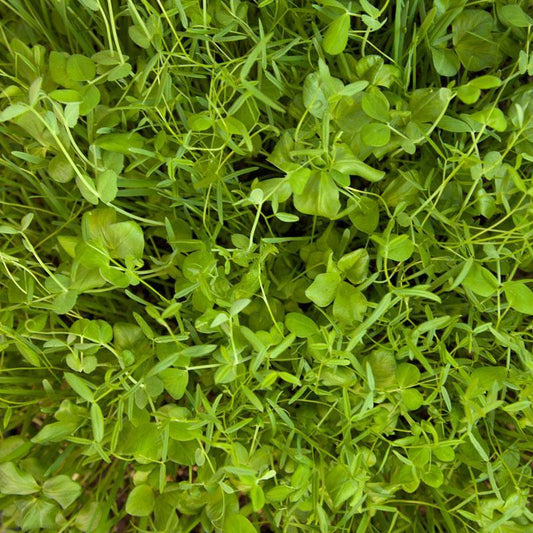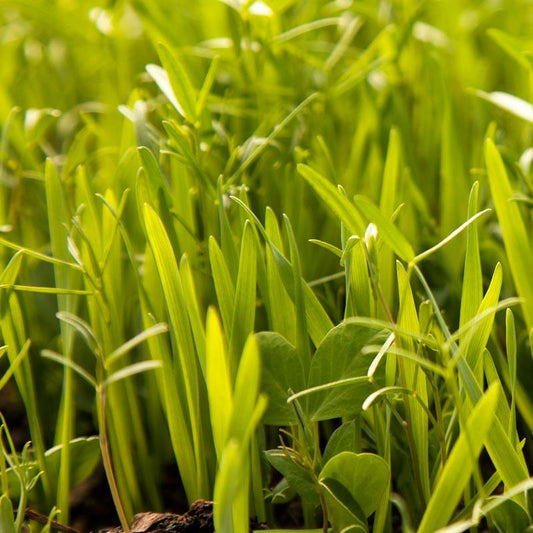What is a Cover Crop?
Planting cover crops is a tried-and-true method for adding organic matter (green manure) and improving fertility of your soil. Cover crops are one of the cornerstones of sustainable agriculture. They are low cost, easy to care for and earth friendly. Cover crops benefit the soil, the crop, and the grower.
Why Cover Crop?
- To provide erosion control.
- To build the soil’s organic matter and humus content, and to improve the structure.
- To increase the microbial activity and biomass in the topsoil and provide food for the soil microbes and earthworms which are vital to plant health.
- To provide competition to weed growth.
- To increase water infiltration from rainfall and irrigation.
- To increase nutrient availability: cover crops extract nutrients from the subsoil and deposit them in the topsoil, thereby increasing their availability.
- To provide a habitat, prey, nectar and pollen for beneficial insects.
Which Cover Crop Should I Plant?
Use our Cover Crop Solution Chart as a general guide to help you choose the best cover crop seed for your growing situation.
Fertility
The soil should be reasonably fertile prior to planting the seeds for these crops. The appropriate fertilizers should be broadcast and worked into the soil during ground preparation. Legumes and grasses grow best where there is an adequate to high level of available phosphorus (P), calcium (Ca), and sulfur (S). If your soil tests or other factors indicate low levels of phosphorus, calcium, or sulfur, it is desirable to apply these nutrients prior to planting the seeds.
The best organic materials for correcting these deficiencies are high quality aerobic compost, soft rock phosphate and gypsum, or limestone.
- Compost will provide some phosphorus, calcium and sulfur, as well as providing the soil with humus, humic acids, microbes, and minerals. Rates to use should be determined by a soil analysis, but generally 2–4 tons per acre or home garden rates of 1 pound per 2–10 square feet of high quality aerobically digested compost are adequate. Lower quality materials or raw manures will require higher amounts.
- Soft rock phosphate, a fine powdered material, will provide 16–20% phosphorus along with approximately 20% calcium. This material gives excellent results in most soil types, particularly when applied with compost.
- Gypsum will supply calcium and sulfur, as well as some trace elements.
- Limestone will add calcium and raise the pH level of your soil.
A lack of fertility will prevent you from obtaining the excellent stand you are attempting to establish.
Storage of Seeds
Seeds are living organisms that need reasonable care in order to ensure their top performance. Store in the dark at temperatures between 40–75ºF. Keep seeds dry and protect them from freezing.
Soil Preparation
If you are fortunate enough to have access to a no till drill for planting, seed bed preparation can be fairly minimal, because the seeder will plant into almost anything. For the rest of us, soil preparation prior to planting is very important. Breaking up the soil reduces competition from weeds.
Tillage also loosens the soil allowing the seedling roots to grow rapidly to reach moisture and provide anchorage. The tillage only needs to be as fine as the seeds to be planted. Fine seeded crops need a better seed bed than large seeds like peas, beans, grains or vetch.
Legume Seed Inoculation
A very important relationship exists between the legume plants and a group of soil bacteria commonly known as Rhizobium. This symbiotic relationship allows the bacteria to live on the roots of the legume plant, consuming carbohydrates from the plant and providing the plant with nitrogen that the bacteria convert from gaseous nitrogen to plant usable forms.
Without these bacteria, legumes do not fix nitrogen! Most soils do not contain very many, if any, of these bacteria. In order to ensure good nitrogen fixation by the legume, it is necessary to inoculate the legume with the proper strains of the bacteria prior to planting the legume seeds.
It is important to use the correct inoculant for the seed you are planting. Some seeds are already coated in an inoculant; these seeds are marked as “nitro-coated.” “Raw” or uninoculated legume seeds, will need an inoculant to enjoy the full benefits of a cover crop.
Planting Depth
It is important to plant the seeds at the right depth in the soil. Too deep will inhibit germination, reduce seedling vigor and increase the risk of seed rot during and after germination. Planting cover crop seeds too shallow will expose the seed to drying out between irrigations or rainfall, erosion by wind and water, or predation by birds and rodents.
Generally, large seeds are planted at deeper depths because they have greater ability to push up though the soil than the small seed types. Small seeds, which have weaker emergence vigor, need to be planted quite shallow to obtain good germination. Poor germination and a poor stand is the common result from planting too deep. A good rule of thumb: if you don’t know the optimum planting depth, plant the seed no deeper than 2 times the width of the seed.
If you plant on the shallow side it is very important to keep adequate moisture near the seed to enhance germination. If the soil stays consistently moist during germination, then you’ll have a better stand of plants. Keeping the soil irrigated also reduces the problem of crusting over, which can inhibit germination.
Seeding
No Till Drilling: This is the best method of seeding as the drill places seed into almost anything, and closest to the optimal seed depth for maximum germination.
Broadcast Seed: If using a broadcast seeder you will need to take extra precautions to ensure a good stand of cover crop seeds. The soil should be disced, tilled or spaded prior to seeding, cover the seed to the correct depth. If using mulches to cover the seed please see the information on mulching.
Because broadcast seeding does not spread the seed uniformly, you must use more seed to make up for the likelihood of poorer germination. The seed needs to be at the proper depth for good germination, resistance to drought and excess rainfall, to exclude bird predation and to preserve the viability of the inoculant which is on the seed.
Mulching Seed: Instead of planting seed into the soil, you can broadcast the seed, then mulch on top of it. The seed should not be left exposed on the soil surface. Mulch should be placed only as thick as the normal planting depth as if sowing the seed into the soil.
Planting in Dryland (Non-Irrigated) Conditions
When planting cover crops where one is to rely on rainfall for germination, the germination rate will be radically affected by the timeliness, or lack thereof, of rain. Good soil preparation is important in these conditions to improve germination rates. Generally, the seeds are planted at the deepest recommended depth to improve resistance to desiccation. See comments on supplemental irrigation at the end of the “planting dates” section below.
Planting Dates
Annual cool weather cover crops, erosion control mixes, dryland pasture mixes and alfalfa: Planting the seed at the optimum time is very important for success with these plants. The difference of a few weeks can make a large difference in crop performance. The best planting dates for the majority of United States to plant cool weather over-wintering plants such as cover crops, erosion control mixes, alfalfa and dryland pasture mixes are September 1 to October 15. In higher elevations or colder areas, August 15 to September 15 is optimum.
The seeds need to germinate and make some growth while the soil is still moderately warm and the days have not grown short. Later plantings often have reduced germination rates and will make considerably less growth during the low light, low temperature days of Winter. They also tend to take longer to mature in the spring thus requiring better spring management.
November, December and January plantings germinate slowly, if at all, don’t compete well with weeds, and do not grow nearly as well as the same seeds planted within the proper time window.
If you must plant outside the optimum time for your zone, then it is necessary to increase the seeding rate by 25–50%, due to the expected low germination in the cool soils. On erosion control and pasture plantings, increasing seeding rate by 100–150% will increase the ability to get a good stand.
Do not delay planting to wait for the rain. It is better to have the seed in the ground waiting for the rain than to plant after fall rains begin. If possible, irrigation should be applied immediately after planting.
The irrigation should be long enough to at least wet the soil to 1–2” below the seeding depth, with 2–3 subsequent irrigations to supplement the early growth, if rains don’t happen in the Fall. The more growth these covers make in the Fall the better.
Annual warm season cover crops: Warm season cover crops need to be planted after the soil has warmed to at least 60ºF and the likelihood of frost has passed. A good rule of thumb is to time the planting of the first warm season cover crops with the average corn planting date in your area, as they have similar requirements.
Turning In Annual Cover Crops
The best time to till in your cover crop is when 50% of the flowers are in bloom. By turning in the cover crop while it is still lush, the cover crop will be rapidly decomposed by soil microbes who will then return nitrogen and other elements to the soil for the next crop.
If the cover crop is shredded, the cover will break down faster. It is important to till the cover crop into the soil as quickly as possible after mowing, as the cover crop loses nitrogen and carbon to the atmosphere very rapidly if left exposed to the sun.
For most cover crops, approximately two-thirds of the nitrogen in the cover crop is in the above ground portion. Depending on the quantity of organic material, the breakdown process will take 10-21 days if the soil is cultivated regularly. If it is too difficult for you to incorporate the cover crop, a second option would be to cut the tops at ground level and put the tops into the compost pile to break down into humus. If the soil remains moist during this breakdown process, no additional water is necessary.
However if the soil is dry when the cover is turned under or loses substantial moisture during the cultivating process, a light irrigation can do wonders to stimulate breakdown.
🌱 Cover Crop Resource Center
Dig deeper into the world of cover crops with these handpicked guides, how-to videos, and seed collections from GrowOrganic. Whether you're a home gardener or a seasoned grower, these resources will help you select, plant, and maintain cover crops for soil health and sustainability.
- 📖 Cover Crop Growing Guide
A complete guide covering everything from soil prep and planting depth to seasonal timing and turning under for green manure. - 📘 Cover Crops: Introduction & Benefits
Explore how cover crops improve fertility, structure, and microbial life in your garden soil. - 🍂 Tips on Planting a Fall Cover Crop
Seasonal advice to help you get the timing and conditions right for successful fall planting. - 🎥 Cover Crop Highlight: Daikon Radish (Video)
Watch how this deep-rooted radish loosens compacted soils and boosts nutrient cycling. - 🌾 Erosion Control with Jute Netting and Cover Crops
Learn how to protect slopes and prevent runoff with this dual-approach erosion control method. - 🛒 Shop Cover Crop Seeds
Browse a full selection of organic cover crop seeds including legumes, grasses, and seasonal blends for every need.


